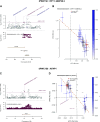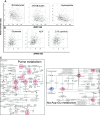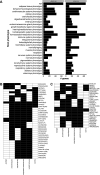Omics-driven investigation of the biology underlying intrinsic submaximal working capacity and its trainability
- PMID: 37661925
- PMCID: PMC11178266
- DOI: 10.1152/physiolgenomics.00163.2022
Omics-driven investigation of the biology underlying intrinsic submaximal working capacity and its trainability
Abstract
Submaximal exercise capacity is an indicator of cardiorespiratory fitness with clinical and public health implications. Submaximal exercise capacity and its response to exercise programs are characterized by heritability levels of about 40%. Using physical working capacity (power output) at a heart rate of 150 beats/min (PWC150) as an indicator of submaximal exercise capacity in subjects of the HERITAGE Family Study, we have undertaken multi-omics and in silico explorations of the underlying biology of PWC150 and its response to 20 wk of endurance training. Our goal was to illuminate the biological processes and identify panels of genes associated with human variability in intrinsic PWC150 (iPWC150) and its trainability (dPWC150). Our bioinformatics approach was based on a combination of genome-wide association, skeletal muscle gene expression, and plasma proteomics and metabolomics experiments. Genes, proteins, and metabolites showing significant associations with iPWC150 or dPWC150 were further queried for the enrichment of biological pathways. We compared genotype-phenotype associations of emerging candidate genes with reported functional consequences of gene knockouts in mouse models. We investigated the associations between DNA variants and multiple muscle and cardiovascular phenotypes measured in HERITAGE subjects. Two panels of prioritized genes of biological relevance to iPWC150 (13 genes) and dPWC150 (6 genes) were identified, supporting the hypothesis that genes and pathways associated with iPWC150 are different from those underlying dPWC150. Finally, the functions of these genes and pathways suggested that human variation in submaximal exercise capacity is mainly driven by skeletal muscle morphology and metabolism and red blood cell oxygen-carrying capacity.NEW & NOTEWORTHY Multi-omics and in silico explorations of the genes and underlying biology of submaximal exercise capacity and its response to 20 wk of endurance training were undertaken. Prioritized genes were identified: 13 genes for variation in submaximal exercise capacity in the sedentary state and 5 genes for the response level to endurance training, with no overlap between them. Genes and pathways associated with submaximal exercise capacity in the sedentary state are different from those underlying trainability.
Keywords: cardiorespiratory fitness; genomics; metabolomics; proteomics; transcriptomics.
Conflict of interest statement
No conflicts of interest, financial or otherwise, are declared by the authors.
Figures











Similar articles
-
Exploring the underlying biology of intrinsic cardiorespiratory fitness through integrative analysis of genomic variants and muscle gene expression profiling.J Appl Physiol (1985). 2019 May 1;126(5):1292-1314. doi: 10.1152/japplphysiol.00035.2018. Epub 2019 Jan 3. J Appl Physiol (1985). 2019. PMID: 30605401 Free PMC article.
-
Fine mapping of a QTL on chromosome 13 for submaximal exercise capacity training response: the HERITAGE Family Study.Eur J Appl Physiol. 2012 Aug;112(8):2969-78. doi: 10.1007/s00421-011-2274-8. Epub 2011 Dec 15. Eur J Appl Physiol. 2012. PMID: 22170014 Free PMC article.
-
Heritability of submaximal exercise heart rate response to exercise training is accounted for by nine SNPs.J Appl Physiol (1985). 2012 Mar;112(5):892-7. doi: 10.1152/japplphysiol.01287.2011. Epub 2011 Dec 15. J Appl Physiol (1985). 2012. PMID: 22174390 Free PMC article.
-
Genomic and transcriptomic predictors of response levels to endurance exercise training.J Physiol. 2017 May 1;595(9):2931-2939. doi: 10.1113/JP272559. Epub 2016 Jul 3. J Physiol. 2017. PMID: 27234805 Free PMC article. Review.
-
The HERITAGE Family Study: A Review of the Effects of Exercise Training on Cardiometabolic Health, with Insights into Molecular Transducers.Med Sci Sports Exerc. 2022 May 1;54(5S):S1-S43. doi: 10.1249/MSS.0000000000002859. Med Sci Sports Exerc. 2022. PMID: 35611651 Free PMC article. Review.
Cited by
-
The constrained-disorder principle defines the functions of systems in nature.Front Netw Physiol. 2024 Dec 18;4:1361915. doi: 10.3389/fnetp.2024.1361915. eCollection 2024. Front Netw Physiol. 2024. PMID: 39744508 Free PMC article. Review.
-
Metabolic Predictors of Cardiorespiratory Fitness Responsiveness to Continuous Endurance and High-Intensity Interval Training Programs: The TIMES Study-A Randomized Controlled Trial.Metabolites. 2024 Sep 23;14(9):512. doi: 10.3390/metabo14090512. Metabolites. 2024. PMID: 39330519 Free PMC article.
-
An optimized method for gene knockdown in differentiating human and mouse adipocyte cultures.bioRxiv [Preprint]. 2023 Dec 15:2023.12.14.571780. doi: 10.1101/2023.12.14.571780. bioRxiv. 2023. PMID: 38168248 Free PMC article. Preprint.
References
-
- Ross R, Blair SN, Arena R, Church TS, Despres JP, Franklin BA, Haskell WL, Kaminsky LA, Levine BD, Lavie CJ, Myers J, Niebauer J, Sallis R, Sawada SS, Sui X, Wisloff U; American Heart Association Physical Activity Committee of the Council on Lifestyle and Cardiometabolic Health; Council on Clinical Cardiology; Council on Epidemiology and Prevention, Council on Cardiovascular and Stroke Nursing; Council on Functional Genomics and Translational Biology; Stroke Council. Importance of assessing cardiorespiratory fitness in clinical practice: a case for fitness as a clinical vital sign: a scientific statement from the American Heart Association. Circulation 134: e653–e699, 2016. doi:10.1161/CIR.0000000000000461. - DOI - PubMed
-
- Kodama S, Saito K, Tanaka S, Maki M, Yachi Y, Asumi M, Sugawara A, Totsuka K, Shimano H, Ohashi Y, Yamada N, Sone H. Cardiorespiratory fitness as a quantitative predictor of all-cause mortality and cardiovascular events in healthy men and women: a meta-analysis. JAMA 301: 2024–2035, 2009. doi:10.1001/jama.2009.681. - DOI - PubMed
MeSH terms
Grants and funding
- R01 DK128057/DK/NIDDK NIH HHS/United States
- R01 NR019628/NR/NINR NIH HHS/United States
- R01 HL047327/HL/NHLBI NIH HHS/United States
- R01 HL047323/HL/NHLBI NIH HHS/United States
- P20 GM103499/GM/NIGMS NIH HHS/United States
- T32 HL125232/HL/NHLBI NIH HHS/United States
- R01 DK081572/DK/NIDDK NIH HHS/United States
- U24 DK112340/DK/NIDDK NIH HHS/United States
- U54 GM104940/GM/NIGMS NIH HHS/United States
- T32 HL007208/HL/NHLBI NIH HHS/United States
- K23 HL164980/HL/NHLBI NIH HHS/United States
- P20 GM103528/GM/NIGMS NIH HHS/United States
- P30 GM118430/GM/NIGMS NIH HHS/United States
- R01 HL045670/HL/NHLBI NIH HHS/United States
- K23 HL150327/HL/NHLBI NIH HHS/United States
- R01 HL047317/HL/NHLBI NIH HHS/United States
- U54 GM115428/GM/NIGMS NIH HHS/United States
- R01 HL146462/HL/NHLBI NIH HHS/United States
LinkOut - more resources
Full Text Sources
Medical

